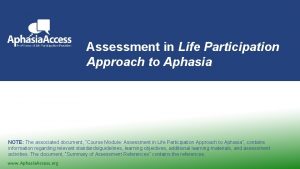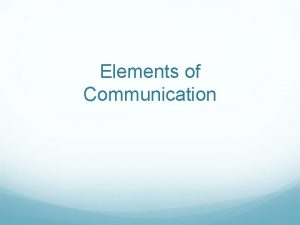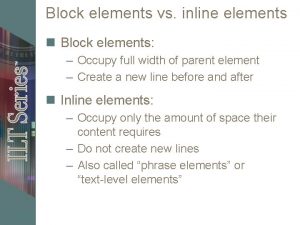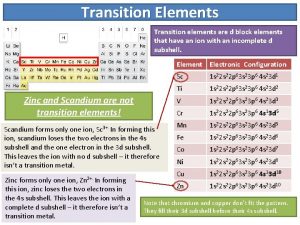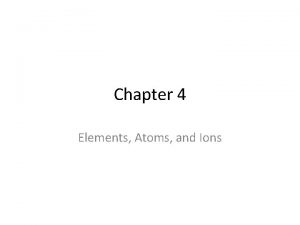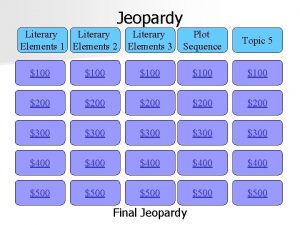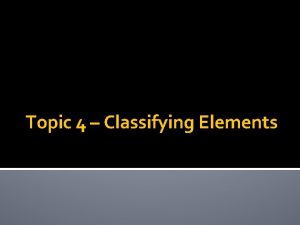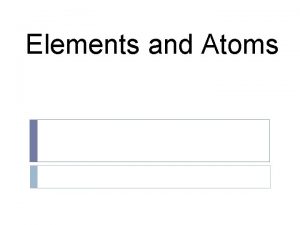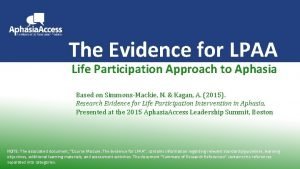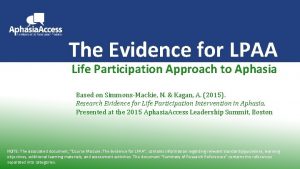Key Elements for Implementation Life Participation Approach to

























































- Slides: 57

Key Elements for Implementation Life Participation Approach to Aphasia NOTE: The associated document, “Life Participation Approach to Aphasia”, contains information regarding relevant standards/guidelines, learning objectives, additional learning materials, and assessment activities. The document “Summary of Research References” contains the references separated into categories. © 2017 Aphasia Access www. Aphasia. Access. org

Academic Module Sponsors www. Aphasia. Access. org

Academic Module Committee www. Aphasia. Access. org

About Aphasia Access www. Aphasia. Access. org • Received its 501 c(3) designation in May 2014 • Membership includes representation from 33 states and 5 Canadian Provinces. The Life Participation Approach to Aphasia (LPAA) is the core philosophy. • Produces videos, webinars and podcasts that are used internationally to educate speech-language pathologists, healthcare professionals, students, nonprofit board members and community leaders. • Advocates for aphasia care and communication access throughout health care.

Target Audience This presentation has been developed for speech-language pathology (SLP) students and current practitioners. www. Aphasia. Access. org

Learning Objectives Upon successful completion of this learning module, participants will be able to: § § § Distinguish key elements in the implementation of LPAA model Identify how LPAA augments/extends impairment based treatment Construct a therapeutic environment that encompasses the LPAA model for PWA www. Aphasia. Access. org

LPAA Curriculum Modules The Working Group on Academic Curricular of the Education and Research Committee of Aphasia. Access has developed this module to § Address how LPAA principles differ from and complement a traditional impairment-based approach for the intervention for PWA. www. Aphasia. Access. org

Life Participation Approach to Aphasia LPAA is a: § § § Person-centered service delivery model, Supports PWA and others affected by it, and Helps them achieve their life goals. The LPAA philosophy seeks to impact a person’s quality of life. The goal is re-engagement in life! www. Aphasia. Access. org

Life Participation Approach to Aphasia LPAA places life concerns of PWA at the center of all decisions. The clinician strengthens daily participation in activities of the client’s choice. The clinician not only works on communication but also on establishing and maintaining social links… for it is within this environment that one communicates. www. Aphasia. Access. org

Life Participation Approach to Aphasia Mission: Minimize the effects of life barriers for all persons (including the stroke survivor with aphasia, family and close friends) connected to this ongoing shift in life. Emphasis is on adjusting feelings/attitudes about self and others. Focus is on strengthening intra-personal and inter-personal communication and increasing participation in activities of choice. www. Aphasia. Access. org

The Focus of LPAA Empowering persons with aphasia to become active agents in determining their direction and involvement in daily life. KEY FACTORS ARE: § § Client driven goals Personal choice of activities and level of participation Engagement of significant others in therapy Expansion of therapeutic settings to include real-life situations and dilemmas www. Aphasia. Access. org

Research Supporting Need for LPAA Operationally, how does one incorporate LPAA into practice and how does it differ from traditional impairment-based therapy? www. Aphasia. Access. org

Living with Aphasia FRAMEWORK FOR OUTCOMES MEASUREMENT (A-FROM) Aphasia Institute, Kagan, Simmons-Mackie, Rowland, et. al. 2008 www. Aphasia. Access. org

How can A-FROM help us think about services for persons with aphasia or a cognitive-linguistic disorder? § § § Services need to address real-life participation Context is key Personal factors Physical and social factors Increasing successful participation in authentic contexts/communication events Providing communicative support systems within the speaker’s community www. Aphasia. Access. org

Overview for Users This presentation will identify the following elements, both within the LPAA model and a traditional impairment-based model of treatment § § § Outcomes Assessment Treatment www. Aphasia. Access. org § § § Persons treated Environment Therapists’ role

Research Supporting Need for LPAA Before looking at each, let’s set the stage. www. Aphasia. Access. org

Premises for LPAA are to: § Increase access while reducing barriers in healthcare, § Facilitate participation in personally relevant activities, and § Create a sense of fulfillment in one’s life. www. Aphasia. Access. org

Research Supporting Need for LPAA Taking at look at OUTCOMES Beginning with the end… Looking at desired outcomes first www. Aphasia. Access. org

What kinds of outcomes can be expected when designing impairment-based intervention? Improvement in skills related to: § § word recall auditory comprehension reading writing www. Aphasia. Access. org § § § discourse (verbal and written) grammar speech intelligibility

What kinds of outcomes can be expected when designing LPAA intervention? Increased behaviors as measured by § § § Engagement Satisfaction of self-chosen activities Natural conversation or communication www. Aphasia. Access. org § § § Social connectedness Emotional well-being Ability to cope, resiliency

What kinds of outcomes can be expected when designing LPAA intervention? Client may be observed to have § § § New discovery of self and others New skills and activities New relationships New meaning in life Renewed energy www. Aphasia. Access. org

Research Supporting Need for LPAA Taking at look at ASSESSMENTS www. Aphasia. Access. org

What assessments are likely given in an impairment-based evaluation? Western Aphasia Battery (WAB) Boston Diagnostic Aphasia Examination (BDAE) Reading Comprehension Battery for Aphasia (RCBA) Aphasia Diagnostic Profiles (ADP) www. Aphasia. Access. org

LPAA: Change in Assessment Focus is on “re-engagement in life. ” § § Discovering competencies Evaluating support systems Assessing client’s chosen activities to re-engage and help determine their level of participation. Assessing life participation barriers and life participation facilitators www. Aphasia. Access. org

What assessments are likely given in an LPAA-based evaluation? (Alphabetical Order) ASHA Quality of Communication Life Scale (ASHA QCL; Paul-Brown et al. 2004) Aphasia Communication Outcome Measure (ACOM; Hula et al. 2015) Assessment for Living with Aphasia (ALA; Kagan et al. 2010) Communication Confidence Rating Scale for Aphasia (CCRSA; Cherney et al. 2011) www. Aphasia. Access. org

What assessments are likely given in an LPAA-based evaluation? (Alphabetical Order) Communication Effectiveness Index (Lomas et al. 1989) Community Integration Questionnaire (with or without pictographs) (CIQ; Willer et al. 1993) Stroke and Aphasia Quality Of Life Scale – 39 (SAQOL-39; Hilari et al. 2003) The Burden of Stroke Scale (BOSS; Doyle et al. 2003) Visual Analogue Mood Scales (VAMS; Stern; 1997) www. Aphasia. Access. org

Role of Narrative as Part of a Holistic Approach to Assessment in LPAA Model Shadden, B. (2007) “The Role of Narrative in the Life Participation Approach to Aphasia. ” Topics in Language Disorders, Volume 27(4), pp. 324 -338. § § Engage client in telling personal, health and/or stroke narratives Suggests Mc. Adams et al. ’s (2006) Life Story interview as a possible means for assessment www. Aphasia. Access. org

Examples of Additional Questions What do we know about the dyadic communication within the home of our clients? § § Are our clients valued and connected with those people they care the most about? Have our couples learned to quickly avoid or ignore conversational realms and/or topics? Are they engaged with each other in a variety of life situations? Are our clients personally, socially and comfortably connected in life? www. Aphasia. Access. org

Research Supporting Need for LPAA Taking at look at GOALS FOR TREATMENT www. Aphasia. Access. org

What goals are likely to be written for impairment-based therapy? The clinician designs goals based on what are viewed as impairments in speech/language/cognition. The clinician works on improving and/or compensating for speech/language/cognitive loss. www. Aphasia. Access. org

What goals are likely to be written for impairment-based therapy? Goals are largely quantitative; explicit behaviors observed and tallied. Goals take the format of an observed behavior (action), that is measurable to a certain achievable level. These behaviors may be discrete language behaviors (e. g. , naming a picture) or functional tasks (e. g. , writing a list). www. Aphasia. Access. org

What goals are likely to be written in an LPAA-based therapeutic environment? The clinician writes client driven goals that address anything where aphasia is a barrier to life participation. www. Aphasia. Access. org

What goals are likely to be written for LPAA-based therapy? Goals shift to engaging in self-chosen daily life activities Goals are for client to demonstrate level of participation in self-chosen activity. Goals are to work toward acceptance of life’s differences with aphasia Goals may lead to discovery of unexpected value or merit in life after stroke with aphasia. www. Aphasia. Access. org

Research Supporting Need for LPAA Let’s take a closer look at GOALS www. Aphasia. Access. org

In the acute setting, a client’s goals may focus on the following: § Education as to what happened § Understanding of safety precautions § Ability to call for help § Ability to compliment/complain § Ability to answer biographical information § Selection of menu § Participation in discharge planning § Ability to give personal health status www. Aphasia. Access. org

Impairment-based and participation-based goals in an acute setting LONG TERM GOAL Client will participate in discharge planning. IMPAIRMENT-BASED SHORT TERM GOAL (STG) Client will respond to multiple choice questions with 80% accuracy. LPAA SHORT TERM GOAL Client will engage in choosing health care options by indicating preference with care provider 80% of the time. www. Aphasia. Access. org

Within an out-patient setting, a client's goals may be: § Ability to order at a restaurant § Ability to follow directions § Participation in a conversation § Participation in family decisions § Ability to communicate electronically www. Aphasia. Access. org

Impairment-based and participation-based goals in an out-patient setting LONG TERM GOAL Client will follow directions in his environment. IMPAIRMENT-BASED SHORT TERM GOAL (STG) Client will follow 2 -3 step directives with 80% accuracy. LPAA SHORT TERM GOAL Client will accurately fill weekly pill box, following directions from partner. www. Aphasia. Access. org

Research Supporting Need for LPAA Take a look at who is included in TREATMENT www. Aphasia. Access. org

Who is likely included in the decision of treatment with impairment-based therapy? • Largely depends on the setting. In acute care, may include an interdisciplinary medical team, such as the physician, nurses, social worker, physical therapist, occupational therapist, recreational therapist, and care manager. • Third party payment reviewers www. Aphasia. Access. org

Who is likely included in the decision of treatment with the LPAA model? Should include anyone who is a vested communication partner. Opportunities may include: § § § Multidisciplinary team Person with aphasia Family/care partner www. Aphasia. Access. org

Research Supporting Need for LPAA Taking a look at the THERAPEUTIC ENVIRONMENT www. Aphasia. Access. org

What does the environment look like with impairment-based therapy in acute care? • In acute care, the environment has more to do with “crisis management. ” It is a medical environment, designed to be expeditious in the delivery of medical intervention. • However, more facilities are intentionally designing spaces for families and friends to feel supported during medical management. www. Aphasia. Access. org

What does the environment look like with impairment-based therapy in subacute care? • In subacute/in-patient rehabilitation units, family training and education, along with patient care, begin to emerge. However, creating an environment for transfer of training to the patient’s “reality” remains problematic. • Likewise, creating a social environment of camaraderie is often negated by isolation. The establishment of support meetings for patients and/or families can be advantageous in creating an environment of mutual support and understanding. www. Aphasia. Access. org

What does the environment look like with LPAA? • Treatment needs to transcend environment so it is “aphasia friendly” and supportive. • A key component of therapy is to create appropriate supports for this transference to the actual environment of the client. www. Aphasia. Access. org

Environment Needs to Complement Social Connectedness The LPAA scope of practice situates the people with aphasia within social contexts (LPAA Project Group, 2000, 2001). This includes external environment • Social settings either in the home or community And the internal environment • Social connectedness felt to others www. Aphasia. Access. org

Regarding the LPAA model, one may consider the client’s environment by… • Taking an inventory of your client’s environments. Where does your client spend time, how often, with whom? • Having your client identify meaningfulness of these home and social settings. • Having your client identify perceived social connectedness in these environments. www. Aphasia. Access. org

Regarding the LPAA model, one may examine the client’s external environment… • What factors influence your client’s comfort level in a these self -identified environments? • What are the barriers to social connectedness in these environments? • What are facilitators to social connectedness in these environments? www. Aphasia. Access. org

Regarding the LPAA model, one may consider identifying factors in the external environment • Does the social environment support the people with aphasia? • Is the noise level controlled? • Are there extraneous noises and activity? • Are communicative partners facing each other? • Are there multiple conversations at once? • Are their physical supports to facilitate conversation, such as paper and pencil? www. Aphasia. Access. org

Regarding the LPAA model, one may examine the client’s external environment… • What is the proximity of furniture in the treatment environment? Does it promote social conversation? • What are the barriers to social connectedness in therapeutic environment? • What are facilitators to social connectedness in therapeutic environment? www. Aphasia. Access. org

Research Supporting Need for LPAA Taking a look at your role as a THERAPIST www. Aphasia. Access. org

The clinician’s role When primarily working with impairments, therapist may be more of a When primarily working in the LPAA model, therapist may be more of a GOAL SETTER COMMUNICATION PARTNER LEADER COACH EXPERT PROBLEM SOLVER www. Aphasia. Access. org

Research Supporting Need for LPAA QUESTIONS www. Aphasia. Access. org

Questions • Can the LPAA philosophy merge with an impairment intervention? If so, how? • Is there a time for impairment-based therapy and a time for the LPAA approach on the continuum of care? Or can these two models complement each other to best serve the client along the continuum of care? If so, how? www. Aphasia. Access. org

Questions • Does decreased impairment result in increased satisfaction in life and participation in life’s desired activities? • If you could create an environment which encapsulates both philosophies, what would it be? www. Aphasia. Access. org

Questions • Think of yourself in acute care. What would change if you implemented an LPAA approach? What might be barriers and how could you circumvent them? What would the potential benefits be to the person with aphasia, rehabilitation team, facility? • If you wanted to implement the LPAA approach into your present setting, what is one thing you would propose? • How could you determine if your clinical setting acknowledges the LPAA approach? www. Aphasia. Access. org

Re-Framing the Environment for the Client Dream your ideal external treatment space/environment. Would it be a physical space or an augmented reality? What is one element you would make sure is present in your environment to promote social connectedness? www. Aphasia. Access. org
 Total participation adalah
Total participation adalah Life participation approach to aphasia
Life participation approach to aphasia Applying agile approach in erp implementation
Applying agile approach in erp implementation Traditional approach to systems implementation
Traditional approach to systems implementation Big bang vs phased implementation approach pros and cons
Big bang vs phased implementation approach pros and cons Big bang vs phased implementation approach pros and cons
Big bang vs phased implementation approach pros and cons Contoh key partners
Contoh key partners Business model canvas tripadvisor
Business model canvas tripadvisor Sdlc analysis phase
Sdlc analysis phase Iso 22301 utbildning
Iso 22301 utbildning Typiska novell drag
Typiska novell drag Nationell inriktning för artificiell intelligens
Nationell inriktning för artificiell intelligens Ekologiskt fotavtryck
Ekologiskt fotavtryck Varför kallas perioden 1918-1939 för mellankrigstiden?
Varför kallas perioden 1918-1939 för mellankrigstiden? En lathund för arbete med kontinuitetshantering
En lathund för arbete med kontinuitetshantering Kassaregister ideell förening
Kassaregister ideell förening Personlig tidbok fylla i
Personlig tidbok fylla i A gastrica
A gastrica Vad är densitet
Vad är densitet Datorkunskap för nybörjare
Datorkunskap för nybörjare Stig kerman
Stig kerman Debatt artikel mall
Debatt artikel mall Magnetsjukhus
Magnetsjukhus Nyckelkompetenser för livslångt lärande
Nyckelkompetenser för livslångt lärande Påbyggnader för flakfordon
Påbyggnader för flakfordon Kraft per area
Kraft per area Offentlig förvaltning
Offentlig förvaltning I gullregnens månad
I gullregnens månad Presentera för publik crossboss
Presentera för publik crossboss Argument för teckenspråk som minoritetsspråk
Argument för teckenspråk som minoritetsspråk Bat mitza
Bat mitza Klassificeringsstruktur för kommunala verksamheter
Klassificeringsstruktur för kommunala verksamheter Mjälthilus
Mjälthilus Claes martinsson
Claes martinsson Centrum för kunskap och säkerhet
Centrum för kunskap och säkerhet Verifikationsplan
Verifikationsplan Mat för unga idrottare
Mat för unga idrottare Verktyg för automatisering av utbetalningar
Verktyg för automatisering av utbetalningar Rutin för avvikelsehantering
Rutin för avvikelsehantering Smärtskolan kunskap för livet
Smärtskolan kunskap för livet Ministerstyre för och nackdelar
Ministerstyre för och nackdelar Tack för att ni har lyssnat
Tack för att ni har lyssnat Hur ser ett referat ut
Hur ser ett referat ut Redogör för vad psykologi är
Redogör för vad psykologi är Stål för stötfångarsystem
Stål för stötfångarsystem Tack för att ni har lyssnat
Tack för att ni har lyssnat Borra hål för knoppar
Borra hål för knoppar Orubbliga rättigheter
Orubbliga rättigheter Formula varians
Formula varians Tack för att ni har lyssnat
Tack för att ni har lyssnat Steg för steg rita
Steg för steg rita Informationskartläggning
Informationskartläggning Tobinskatten för och nackdelar
Tobinskatten för och nackdelar Toppslätskivling effekt
Toppslätskivling effekt Modell för handledningsprocess
Modell för handledningsprocess Egg för emanuel
Egg för emanuel Elektronik för barn
Elektronik för barn Mantel för kvinnor i antikens rom
Mantel för kvinnor i antikens rom

